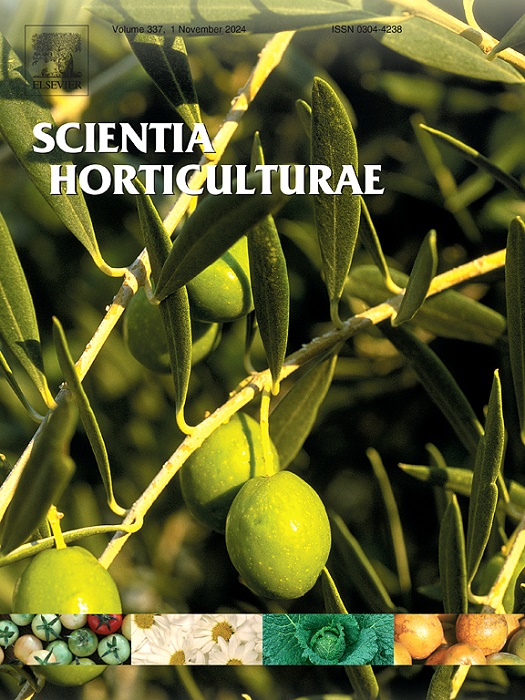Precision irrigation scheduling improves water productivity and economic indicators in young high-density apple orchards
IF 3.9
2区 农林科学
Q1 HORTICULTURE
引用次数: 0
Abstract
Water shortages in arid and semi-arid regions have caused traditional horticulture to move towards high-density orchards. While water productivity (WPc) in high-density orchards has been studied in various contexts, a comprehensive analysis of the key factors influencing it in a water-limited region, which also considers economic indicators, has been lacking. This research innovates by combining the effects of sensor-based precision irrigation and Deficit Irrigation (DI) and shading net on WPc, Economic crop Water Productivity (EWPc), and Economic Energy Productivity (EEP) indicators in high-density apple orchards. This experiment was carried out in northeastern Iran during two growing seasons in 2021–2022, in comparison to EvapoTranspiration-based Irrigation Scheduling (ETS) and Soil Moisture-based Irrigation Scheduling (SMS), as well as shading net treatment (with (S1) and without (S0) shading net) along with the irrigation strategies that included Full Irrigation (FI), Regulated Deficit Irrigation (RDI), and Sustainable Deficit Irrigation (SDI). FI applied 100 % of the crop water requirement at all growth stages, while RDI supplied 60 % of the water requirement between 55 and 105 days after full bloom, maintaining 100 % irrigation at other stages. In contrast, SDI provided 60 % of the water requirement throughout all growth stages. Results showed these techniques and strategies were able to increase WPc by varying amounts, such that the highest WPc was observed with SDI-S1 (11.5 kg/m³) and SDI-SMS (12.7 kg/m³) treatments in 2021 and RDI-SMS (15.9 kg/m³) and RDI-S1 (10.8 kg/m³) treatments in 2022. Similarly, under RDI-S1-SMS (1.3 $/m³ and 2.8 $/m³) treatments, the EWPc values reached in two years, respectively. These findings gained further insights into optimizing WPc and economic indicators for sustainability applications in horticultural development in water-limited regions.
精确灌溉调度提高了高密度苹果园幼龄的水分生产力和经济指标
干旱和半干旱地区的水资源短缺导致传统园艺转向高密度果园。虽然高密度果园的水分生产力已经在各种情况下进行了研究,但缺乏对水资源有限地区影响水分生产力的关键因素的综合分析,其中也考虑了经济指标。本研究结合传感器精准灌溉、亏缺灌溉(DI)和遮阳网对高密度苹果园WPc、经济作物水分生产力(EWPc)和经济能源生产力(EEP)指标的影响进行创新。本试验于2021-2022年的两个生长季节在伊朗东北部进行,比较了基于蒸散发的灌溉计划(ETS)和基于土壤湿度的灌溉计划(SMS)、遮阳网处理(带(S1)和不带(S0)遮阳网)以及包括充分灌溉(FI)、调节亏缺灌溉(RDI)和可持续亏缺灌溉(SDI)在内的灌溉策略。FI在作物生长的所有阶段施用100%的需水量,而RDI在开花后55至105天内提供60%的需水量,在其他阶段保持100%的灌溉。相比之下,SDI在整个生长阶段提供了60%的需水量。结果表明,这些技术和策略能够不同程度地增加WPc,例如,2021年SDI-S1 (11.5 kg/m³)和SDI-SMS (12.7 kg/m³)处理的WPc最高,2022年RDI-SMS (15.9 kg/m³)和RDI-S1 (10.8 kg/m³)处理的WPc最高。同样,在RDI-S1-SMS(1.3美元/m³和2.8美元/m³)处理下,EWPc值分别在两年内达到。这些发现为优化WPc和经济指标在水资源有限地区园艺发展中的可持续性应用提供了进一步的见解。
本文章由计算机程序翻译,如有差异,请以英文原文为准。
求助全文
约1分钟内获得全文
求助全文
来源期刊

Scientia Horticulturae
农林科学-园艺
CiteScore
8.60
自引率
4.70%
发文量
796
审稿时长
47 days
期刊介绍:
Scientia Horticulturae is an international journal publishing research related to horticultural crops. Articles in the journal deal with open or protected production of vegetables, fruits, edible fungi and ornamentals under temperate, subtropical and tropical conditions. Papers in related areas (biochemistry, micropropagation, soil science, plant breeding, plant physiology, phytopathology, etc.) are considered, if they contain information of direct significance to horticulture. Papers on the technical aspects of horticulture (engineering, crop processing, storage, transport etc.) are accepted for publication only if they relate directly to the living product. In the case of plantation crops, those yielding a product that may be used fresh (e.g. tropical vegetables, citrus, bananas, and other fruits) will be considered, while those papers describing the processing of the product (e.g. rubber, tobacco, and quinine) will not. The scope of the journal includes all horticultural crops but does not include speciality crops such as, medicinal crops or forestry crops, such as bamboo. Basic molecular studies without any direct application in horticulture will not be considered for this journal.
 求助内容:
求助内容: 应助结果提醒方式:
应助结果提醒方式:


